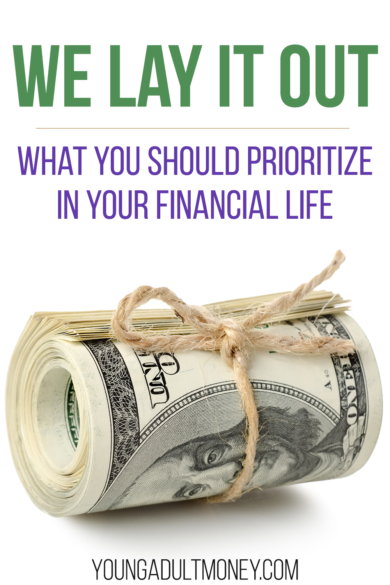 The sheer number of demands on our money can be overwhelming.
The sheer number of demands on our money can be overwhelming.
Credit card bills.
Car payment (and insurance) bills.
Save for a house.
Student loan debt.
Don’t forget about retirement!
The list goes on and on. It’s enough to make someone avoid spending time working on their finances altogether.
That’s why I advocate looking at your top money priority first and then expanding into a more well-rounded strategy for your financial life. By looking at just the top priority or top couple priorities, you can feel good about the progress you are making.
What Your Top Money Priority Should Be
I created a personal finance checklist (that you can download for free) that lays out financial priorities in order of importance. Over my seven years of writing about personal finance I always find myself coming back to an emergency fund as the top financial priority. But you also can’t work on building an emergency fund unless you have positive cash flow, which is why these are the first four actions on the checklist:
- Track your Income and Expenses
- Look for Areas you can Save and Cut Costs
- Start a Budget
- Review your Debt
As you can see, “build an emergency fund” isn’t even in the top four items on the list, and for good reason. It’s easy to tell someone “you need an emergency fund.” If it was easy to do, though, they would either already have one or be in the process of building one.
Even if you track your income and expenses, find areas to save and cut costs, and start budgeting, your debt could still get in the way. If someone makes $35k a year but has $2k a month in debt payments, it’s not going to matter how much they cut out of their spending. They either need to make more money or figure out how to get those debt payments lower.
For those who are drowning in debt and can’t see a realistic way to turn the tide and create positive cash flow while also reducing their debt, it can make sense to meet with a certified credit counselor (through the National Foundation for Credit Counseling) and/or review the situation with a debt attorney (such as Tayne Law Group). They can negotiate your debt to a reasonable amount based on your finances and can potentially cut years off of debt repayment timeline.
For others who aren’t in as dire a situation, creating a reasonable budget and being strategic about their debt may be enough. For example, with federal student loans you have access to income-driven repayment plans that can potentially (drastically) reduce your minimum monthly student loan payment. With high interest credit card debt there is the option of a zero-interest balance transfer credit card or refinancing to a lower interest rate through a personal loan.
The goal is to create positive cash flow by looking at all your options.
Once you have positive cash flow you can start focusing on your top money priority: building an emergency fund.
Building an Emergency Fund: The Top Money Priority
Once you have positive cash flow you can start building an emergency fund, or grow on you already started. Like most things with money, the goal of a 3-6 month emergency fund can be daunting. For some that could mean $15k – $30k, or even more.
Instead of getting stuck on the long-term goal, try to focus on smaller goals. When my wife and I started to build our emergency fund we celebrated the milestones. Our first $500, $1k, $3k, etc. I’m a big fan of building an emergency fund $100 at a time.
While not everyone is privileged to be in a job that has a bonus, move up to a higher-paying job, or receive a windfall such as an inheritance, any one of these things can be leveraged to boost your emergency fund.
My employer has an Employee Stock Purchase Program where you can contribute up to 10% of your paycheck. Every six months those funds are used to purchase stock at a discount. Getting the stock at a discount is obviously a big benefit, but even more so was the forced 10% savings each paycheck. Every six months you get a sizable amount deposited in your Fidelity account, which is then an option to boost your emergency fund. These sorts of opportunities are great ways to supercharge your emergency fund.
Again, not everyone will have these opportunities. Sometimes you can create these opportunities yourself by using your spare time to side hustle, selling things you own, or finding new opportunities to save money. For the past five years my wife and I have rarely paid full price for a flight. It takes some work, but the more things you try the easier it will be to tell what’s worth your time and what’s not. For example you may not get the returns you want from taking surveys for extra money, but you may find blogging to be an enticing way to make money outside of your 9-5 (I did).
Building an Emergency Fund: The Top Money Priority
Because of the demands on our money I think it makes sense to focus on an emergency fund above all else. But once you’ve reached that goal, I am a big fan of a balanced approach to your finances. I am not one to say you need to go “all out” on debt and eliminate it as quickly as possible, at the expense of investing. Each situation is different and will call for a different strategy.
For example, if you have high interest credit card debt that will definitely be a priority over investing, but not over investing in an account where you get a dollar-for-dollar match from an employer. If you have low interest debt (i.e. 4%) you are likely better off investing in an index fund instead of making extra payments towards debt.
First things first: make your top money priority building an emergency fund. From there look at your entire financial picture to pick strategies that make sense for you.

